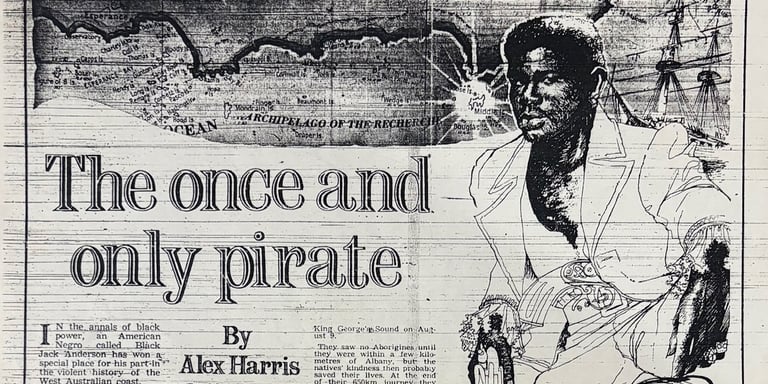East of 121: five minute histories from Esperance - available to order now
Black Jack Anderson and the Mountaineer
History
Karli Florisson
7/29/20257 min read


Black Jack Anderson and the Mountaineer
(This is an excerpt from East of 121: Five Minute Histories from Esperance, a story about one of the most notorious figures from Esperance's history, Black Jack Anderson. I wrote about Anderson for the Esperance Tide, which is where this article originally appeared. I've also done an episode of the Wild: Stories from Western Australia's Past about Black Jack Anderson, available wherever you listen to podcasts.)
‘The Once and Only Pirate’ reads the title of an article about Black Jack Anderson, Esperance’s most notorious historical figure, proclaiming that he was our ‘first and only pirate’.[i] Was Anderson really a pirate? While this story has been romanticised over the years, the true history of Black Jack Anderson is much more bloody and dark than articles like this might lead us to believe.
John Anderson, known as Black Jack, came to the Recherche Archipelago in 1835 on board a small cutter called the Mountaineer, captained by Evanson Jansen. The Mountaineer was travelling from Tasmania to Albany, the latter a fledgling colony which at that stage was only nine years old. Anderson was travelling with his own whaling boat and crew. As the Mountaineer passed through the Recherche Archipelago, Jansen left Anderson and his crew on Middle Island, where they set up a sealing camp. Middle Island, the largest Island in the Recherche Archipelago, is located about 9 kilometres off the coast of Cape Arid, and is about 6.5 kilometres long. At the time, sealing was a large industry, and with salt to preserve the skins readily available from Lake Hillier, Middle Island was an attractive location for a sealing crew.
Before coming to the Recherche Archipelago, Anderson was living on Kangaroo Island, off the coast of South Australia. At that time, Kangaroo Island was home mostly to groups of whalers, sealers, and escaped convicts, and it was a lawless, rough place. By 1826, the population of Kangaroo Island was around 200, and the sealers there were known to kidnap Aboriginal women and force them into what was essentially slavery, working for the men on the island.[ii] ‘Black Jack’ Anderson first appears on Kangaroo Island in these early years, referred to as an American Negro who lived on the island for a number of years – although records in those days were very patchy.[iii] There were several John Andersons recorded in the Australian colonies at that time[iv], and while he could have been a free settler or a former convict, it is most likely that Anderson had deserted from an American whaling ship. When he came to the Recherche Archipelago, Anderson had a small crew with him, including a man called James Manning, and two or three Aboriginal women. Manning would later testify that Anderson and his crew had abducted the women from the Port Lincoln area, murdering their husbands and possibly their children.[v]
The Mountaineer continued on her journey to Albany, arriving on the 22nd of February, 1835. On the 14th of March, the ship set out on its return journey. On board was a young man named James Newell, along with his two sisters, Dorothea[vi] and Mary, and Mary’s husband Matthew Gill. [vii] James’s father, James Newell senior, was an English farm labourer who had come to Albany in 1832 with his wife and seven children. There is some suggestion that Newell was transported to Australia as a convict, but this seems to be a case of mistaken identity.[viii] He was given 4 acres of land on Mount Clarence to settle. In 1835, the three children, James, Dorothea, and Mary, were travelling to the eastern colonies in search of better opportunities.
The Mountaineer’s return journey was troubled from the start, as Jansen, the captain, was ‘always drunk’.[ix] After taking shelter from a storm at Thistle Cove, to the east of what would become Esperance, the Mountaineer was driven onshore in a gale and wrecked. There were no casualties, but the survivors weren’t able to salvage much from the wreckage, except for a small whaleboat. While at Thistle Cove, they were met by a group of five Aboriginal people, who were friendly and probably quite curious about the shipwreck survivors. Realising that it could be a long time before another ship passed by the isolated bay, Captain Jansen and the passengers and crew of the Mountaineer, nine people in total, set out for Middle Island in the ship’s whaleboat. This journey took them three days. Then, after a couple of weeks on Middle Island with Anderson, some of the crew, including the Mountaineer’s captain, left for Albany in the whaleboat. The boat was most likely wrecked on the journey, as there is no record of them ever arriving. James and Dorothea Newell were among those who stayed on Middle Island.
Life on Middle Island would have been very harsh. Anderson, who was a physically imposing person, was notoriously violent. He was later described in an article:
A man of colour of the name Anderson, and lawless as these men were, they looked up to him with a sort of dread. Anderson usually carried a brace of pistols about him, knowing that he held his life by a very precarious tenure.[x]
While the sealers had a rudimentary camp on the island, with some stores that they had brought with them, most of their food would have come from the island. Along with seals, Cape Barren geese were a big part of the sealers’ diet. Incidentally, both the fur seals and Australian sea lions that live in the Recherche Archipelago were almost entirely killed out by sealing, before the government imposed protections on them. Despite Anderson’s fierce demeanour, after a few weeks, Dorothea moved into his hut with him.[xi]
According to James Manning’s later testimony, when he arrived on the island, he had with him £46 in Spanish dollars and silver. After a couple of months living on Middle Island, Manning accused Anderson of stealing his money. In the ensuing quarrel, James Newell sided with Manning. In response, Anderson dropped Newell and Manning off on the mainland, without any provisions, water, or weapons. The two young men somehow managed to survive, eating seaweed and limpets, while making their way around the coast to Albany for two months. At that time, there were no European settlements to the east of the Albany region. Not far from Albany, they were found, almost dead, by a group of Aboriginal people, who ‘nursed, fed, and almost carried them at times, when, from weakness, they were sinking under their sufferings.’[xii] These Aboriginal people, described as being from the White Cockatoo, Murray, and Will-men tribes, undoubtedly saved Manning and Newell’s lives, helping them get to the settlement in Albany. The Aboriginal people were rewarded for their actions with a small portion of flour each, and ‘presents to those who were most active and kind in the journey’.[xiii]
Manning and Newell went to the Justice of the Peace at Albany, and told him about Anderson and the money that he had stolen from them. Anderson was apprehended, probably on his next trip to Albany to sell the seal skins, and brought to court. The court case, which was a big event for the fledgling settlement, took place in September, 1835. Manning and Newell gave evidence against Anderson and one of his crew members, Isaac Winterbourne, but in the end, Anderson and Winterbourne were acquitted of the theft, partly because Dorothea gave evidence in Black Jack’s favour.
Anderson went back to sealing on Middle Island, although he ended up back in court in Albany in 1836, accused of stealing provisions from a boat near Michaelmas Island, off the coast of Albany. He received very lenient charges, and went back to sealing on Middle Island. Soon afterwards, Anderson’s violent ways caught up with him. He was killed in December of 1836, shot in his sleep by his own crew. A sealer from Albany, Robert Gamble, later gave evidence that he buried Anderson’s body on nearby Mondrain Island on the 25th of December, 1836.[xiv] After this, Anderson’s crew scattered, out of fear of being charged for his murder. There is no record of what happened to the Aboriginal women, although one account says that they, too, were killed by Anderson’s crew.[xv] Despite rumours that Anderson may have left some money hidden on one of the islands, no such treasure has been discovered and it is likely that any money he had was stolen by his crew.
Dorothea Newell lived the rest of her life in Albany and, after Anderson’s death, she married a shopkeeper called George Pettit. James Newell, too, stayed in Albany and, although he didn’t marry, he had a child with a Menang woman called Pippin.
Anderson remains a figure of legend in the Esperance region, but there is little evidence of him being a ‘pirate’. He was undoubtedly a fierce, lawless man who stole, murdered, and kept his crew under control using threats of violence, but this was not uncommon among the sealers of the time. While the story remains a fascinating part of the region’s history, perhaps the real heroes of the tale were James Manning and James Newell, and the Menang people who saved their lives on their long walk back to Albany.
[i] Alex Harris, ‘The Once and Only Pirate’, West Australian Magazine, 20 July 1974
[ii] J. S. Cumpston, Kangaroo Island, 1800-1836, Canberra, 1974, p. 37
[iii] Wynnis Ruediger, Border’s Land, Kangaroo Island 1802-1836, Morgan, South Australia, 1980, p. 76
[iv] Robert M. Warneke, Histories of Sealing in Australia, 2019, accessed at www.libraries.tas.gov.au/Digital-Stream/b744e341-9c34-4e89-ae06-930ec725fca5
[v] Albany Court Records, Testimony of James Manning, 13 August 1835, SROWA Series 1686, Cons 348
[vi] Dorothea was sometimes referred to as Dorothy, but she was baptised as Dorothea, as per her baptism record from the parish of Elstead, England, Dec 1816
[vii] ‘Mountaineer’, Shipwreck Databases, Western Australian Museum, www.museum.wa.gov.au/maritime-archaeology-db/wrecks/id-1529
[viii] Ciaran Lynch, ‘Jimmy Newhill’s Harbour’, The View From Mount Clarence, www.theviewfrommountclarence.com
[ix] ‘Two English Lads’, The Perth Gazette and Western Australian Journal, 3 Oct 1835
[x] ‘Remarks Respecting the Islands on the Coast of S. W. Australia’, The Perth Gazette and Western Australian Journal, 8 Oct 1842
[xi] Albany Court Records, Testimony of Dorothy Newell, SROWA Series 1686, Cons 348
[xii] ‘Two English Lads’, The Perth Gazette and Western Australian Journal, 3 Oct 1835
[xiii] ‘Two English Lads’, The Perth Gazette and Western Australian Journal, 3 Oct 1835
[xiv] Albany Court Records, Declaration sworn by Robert Gamble, 29 March 1837, SROWA Series 1686, Cons 348
[xv] Alex Harris, ‘The Once and Only Pirate’, West Australian Magazine, 20 July 1974
Stories and History from Western Australia
By Karli Florisson
© 2025. All rights reserved.
To support my work, you can use this link to buy me a coffee.
